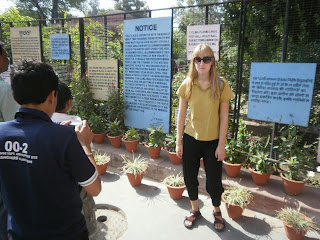 |
| Tying the bags on the bus |
 |
| Buddhist temple |
 |
| Himalayan foothills |
Escaping mosquitoes, inquisitive stares and busy India, we instead embraced chilly nights, powerful mountains and humble Tibetans as we landed in Dharamsala in the far northern province of Himachal Pradesh. Dharamsala/McLeod Ganj is the home of the Tibetan spiritual leader the Dalai Lama and other Tibetan refugees fleeing Chinese oppression in their homeland. So in many ways it felt like we were more in Tibet than India. Tibetans largely populated this town with plenty of Tibetan culture and food. Tibetan food consisted of things like
momos (similar to dumplings; dough balls stuffed with veg),
thankthuk (noodle soup),
tsampa (barley porridge) and
tingmo (steamed bread).
 |
| Massive Buddha in the main Gompa, with offerings of cookies and Tropicana Orange Juice. |
 |
| Prayer wheels |
We spent our days watching documentaries about the genocide in Tibet, walking in the beautiful scenery and detoxing in the crisp mountain air. The Dalai Lama made a brief appearance and the Children's Village where he held a teaching which we sadly, slept in and missed.
We also took part in a clean up effort of the Bhagsu waterfall which was, like most places in India, covered in plastic rubbish. We cleaned up at least 20 large bags of trash, with Indian and foreigners alike helping out.






















